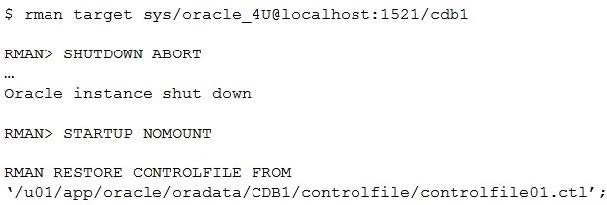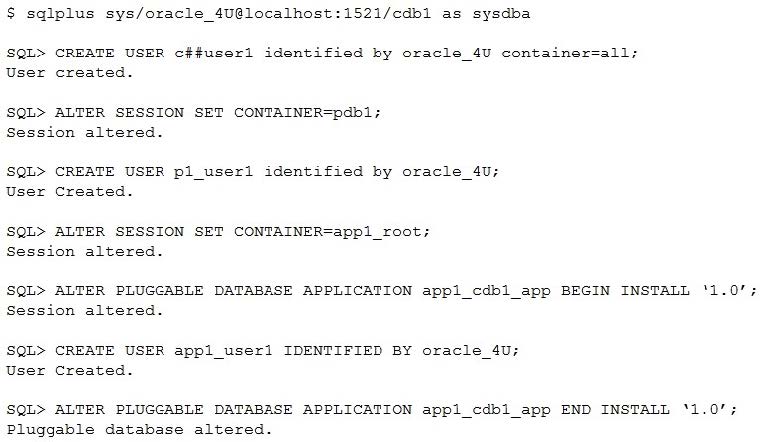Exam Details
Exam Code
:1Z0-083Exam Name
:Oracle Database Administration IICertification
:Oracle CertificationsVendor
:OracleTotal Questions
:273 Q&AsLast Updated
:Mar 26, 2025
Oracle Oracle Certifications 1Z0-083 Questions & Answers
-
Question 221:
Examine this configuration:

While CDB1 is open, `/u02/app/oracle/fast_recover_area/cdb1/CDB1/controlfile02.ctl' is accidentally deleted. To recover from this critical failure, you execute these commands:

What will be the outcome?
A. It will create `$ORACLE_HOME/dbs/cdb1/CDB1/controlfile02.ctl'
B. It will create `/u01/app/oralce/oradata/CDB1/controlfile/controlfile02.ctl'.
C. It will re-create `/u02/app/oracle/fast_recover_area/cdb1/CDB1/controlfile02.ctl'
D. It will create `/u01/app/oracle/product/12.2.0.1/db_1/dbs/snapcf_cdb1control02.ctl'.
E. It will fail because there is no autobackup of the controlfiles.
-
Question 222:
Examine these actions:
1.
Create a new database for a recovery catalog.
2.
Create a tablespace with sufficient space in the catalog database for the recovery catalog.
3.
Configure ARCHIVELOG mode for the catalog database.
4.
Create a user to own the recovery catalog schema with quota on the tablespace that will contain the catalog.
5.
Grant the RECOVERY_CATALOG_OWNER role to the recovery catalog schema owner.
6.
Grant the SYSBACKUP privilege to the recovery catalog schema owner.
Which are the minimum actions that must be performed before executing the CREATE CATALOG command?
A. 2, 4, 5, 6
B. 1, 2, 3, 4, 5, 6
C. 1, 2, 4, 5
D. 2, 4, 5
E. 1, 3, 4, 5
-
Question 223:
Which three actions are performed by Database Upgrade Assistant (DBUA)? (Choose three.)
A. It recompiles all stored PL/SQL code by using utlrp.sql.
B. It empties the RECYCLE BIN.
C. It performs prerequisite checks to verify if the Oracle database is ready for upgrade.
D. It sets all user tablespaces to "read-only" before starting the upgrade.
E. It removes the AUDSYS schema and the AUDIT_ADMIN and AUDIT_VIEWER roles
F. It increases tablespace size, if required, to meet upgrade requirements.
-
Question 224:
Which two are true about RMAN backups when using a media manager to write backups to tape when there are only two tape drives? (Choose two.)
A. SBT tape compression can be used even if no RMAN compression is configured.
B. Any backup set written to the SBT device in this configuration can contain a maximum of two backup pieces.
C. Any backup written to the SBT device in this configuration can contain a maximum of two backup sets.
D. SBT tape compression and RMAN backup compression should be used in parallel.
E. The SBT device should be configured to use PARALLELISM 2 to allow both tape drive to be used simultaneously.
-
Question 225:
Which two are true about duplicating pluggable databases (PDBs) with RMAN? (Choose two.)
A. Two or more PDBs can be duplicated with the same RMAN DUPLICATE command.
B. All tablespaces belonging to a PDB must be duplicated when duplicating the PDB.
C. The auxiliary instance is automatically created with ENABLE_PLUGGABLE_DATABASE = TRUE.
D. A user with SYSDBA or SYSBACKUP must be logged in with RMAN to the PDB to duplicate it.
E. CDB$ROOT and PDB$SEED are automatically duplicated.
-
Question 226:
Which three are true about Rapid Home Provisioning (RHP), which has been available since Orcale 18c? (Choose three.)
A. It is an Oracle Database service
B. It cannot be used to upgrade Oracle Database homes.
C. It can be used to provision applications.
D. It can be used to patch Grid Infrastructure homes containing Oracle Restart.
E. It can be used to provision middleware.
F. It is an Oracle Grid Infrastructure service.
-
Question 227:
Examine this configuration:
1.
CDB1 is a container database.
2.
COMMON_USER_PREFIX is C##.
3.
PDB1 is a pluggable database contained in CDB1.
4.
APP1_ROOT is an application container contained in CDB1.
5.
APP1_PDB1 is an application PDB contained in APP1_ROOT.
You execute these commands successfully:

Which two are true? (Choose two.)
A. APP1_USER1 can be created in PDB1.
B. APP1_USER1 can be created in CDB1.
C. APP1_USER1 can have different privileges in each Application PDB contained in APP1_ROOT.
D. C##_APP_USER1 can be created in CDB1.
E. P1_USER1 can be created in CDB1.
F. C##_USER1 will have the same privileges and roles granted in all PDBs in CDB1.
-
Question 228:
Which three are true about managing memory components in an Oracle database instance? (Choose three.)
A. With Automatic Shared Memory Management, the database instance can increase the Large Pool size by reducing the Shared Pool size.
B. With Automatic Memory Management, the database instance can increase the System Global Area size by reducing the Program Global Area size.
C. Automatically tuned and resized System Global Area components will always revert to their initial sizes after an instance restart.
D. Automatic Memory Management must be used together with locking the System Global Area into physical memory.
E. With Automatic Shared Memory Management, the database instance can increase the Program Global Area size by reducing the System Global Area size.
F. On Line Transaction Processing systems often use less Program Global Area than Decision Support Systems.
-
Question 229:
Which two are facets of performance planning that should always be considered or implemented for an Oracle Database environment? (Choose two.)
A. defining primary keys for all tables to speed up all queries
B. using check constraints to speed up updates
C. defining foreign keys for all tables to speed up joins
D. the physical data model
E. the configuration of storage arrays
-
Question 230:
Which three are true about Database Point-in-Time Recovery? (Choose three.)
A. The database must have FLASHBACK DATABASE ON to perform Database Point-in-Time Recovery.
B. The database must be in MOUNT state when performing Database Point-in-Time Recovery.
C. Database Point-in-Time Recovery is performed by the Managed Recovery Process (MRP)
D. The Database must be in ARCHIVELOG mode.
E. The target point for the recovery must be specified as a stime or System Change Number (SCN).
F. The database must be open RESETLOGS after Database Point-in-Time Recovery.
Related Exams:
1Z0-020
Oracle8i: New Features for Administrators1Z0-023
Architecture and Administration1Z0-024
Performance Tuning1Z0-025
Backup and Recovery1Z0-026
Network Administration1Z0-034
Upgrade Oracle9i/10g OCA to Oracle Database OCP1Z0-036
Managing Oracle9i on Linux1Z0-041
Oracle Database 10g: DBA Assessment1Z0-052
Oracle Database 11g: Administration Workshop I1Z0-053
Oracle Database 11g: Administration II
Tips on How to Prepare for the Exams
Nowadays, the certification exams become more and more important and required by more and more enterprises when applying for a job. But how to prepare for the exam effectively? How to prepare for the exam in a short time with less efforts? How to get a ideal result and how to find the most reliable resources? Here on Vcedump.com, you will find all the answers. Vcedump.com provide not only Oracle exam questions, answers and explanations but also complete assistance on your exam preparation and certification application. If you are confused on your 1Z0-083 exam preparations and Oracle certification application, do not hesitate to visit our Vcedump.com to find your solutions here.